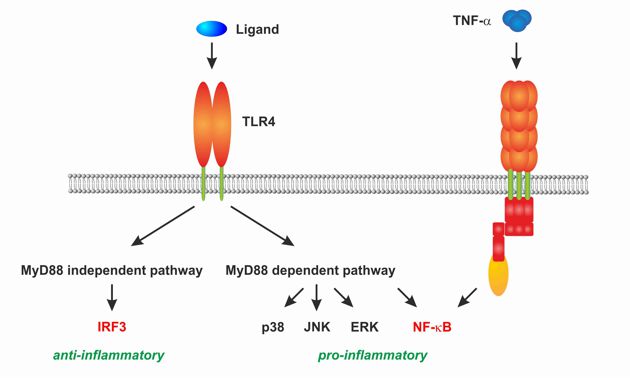Adult stem cells are tissue resident and thus affected by local injury, infection and inflammation. However, the impact of pro- and anti-inflammatory signalling on stem cells is not fully understood. In particular, inflammation seems to have different effects on proliferation, differentiation and migration of stem cells depending on the origin of the cell (tissue and species), the developmental context (embryonic vs adult) and the duration of the exposure to the signal (acute vs. chronic inflammation).
Here, we are mainly interested in the signalling cascaded mediated by the Toll-like Receptor 4 (TLR4) and Tumor Necrosis Factor Receptor 1 (TNF-R1). Notably, while stimulation of TNF-R1 leads to activation of pro-inflammatory signalling, ligation of TLR4 culminates in both: pro- and anti-inflammatory signal transduction.

Fig. 1. Activation of TLR4 can culminate in pro- and anti-inflammatory signalling. In contrast, binding of Tumor Necrosis Factor-alpha to TNF-R1 exclusively activates pro-inflammatory signalling mainly mediated by the transcription factor NF-kappaB.
We want to understand how the inflammatory balance and manipulation thereof influences differentiation, proliferation and migration of stem cells, including neural stem cells, mesenchymal stem cells and neural crest-derived stem cells. We use modern microscopy in addition to biochemical methods to understand the respective signal transduction pathways at the level of receptors and the downstream signalling events.

Fig. 2. Treatment of U251 model cell line with the TLR4-ligand LPS leads to nuclear translocation of the pro-inflammatory transcription factor NF-kappaB as visualized using antibodies against its subunit p65.
Our work on TLR4 is a collaboration with Prof. Mike Heilemann (Institute for Physical and Theoretical Chemistry Goethe-University Frankfurt, Germany) and is funded by the German Research Council DFG (WI4318/2-1).
References
Zeuner M, Bieback K, Widera D. Controversial Role of Toll-like Receptor 4 in Adult Stem Cells.Stem Cell Rev. 2015 Aug;11(4):621-34. doi: 10.1007/s12015-015-9589-5.
Fricke F, Malkusch S, Wangorsch G, Greiner JF, Kaltschmidt B, Kaltschmidt C, Widera D, Dandekar T, Heilemann M.Quantitative single-molecule localization microscopy combined with rule-based modeling reveals ligand-induced TNF-R1 reorganization toward higher-order oligomers. Histochem Cell Biol. 2014 Jul;142(1):91-101. doi: 10.1007/s00418-014-1195-0. Epub 2014 Feb 12.
Heidbreder M, Zander C, Malkusch S, Widera D, Kaltschmidt B, Kaltschmidt C, Nair D, Choquet D, Sibarita JB, Heilemann M.TNF-α influences the lateral dynamics of TNF receptor I in living cells. Biochim Biophys Acta. 2012 Oct;1823(10):1984-9. doi: 10.1016/j.bbamcr.2012.06.026. Epub 2012 Jun 27.
Heidbreder M, Endesfelder U, van de Linde S, Hennig S, Widera D, Kaltschmidt B, Kaltschmidt C, Heilemann M. Subdiffraction fluorescence imaging of biomolecular structure and distributions with quantum dots. Biochim Biophys Acta. 2010 Oct;1803(10):1224-9. doi: 10.1016/j.bbamcr.2010.06.004. Epub 2010 Jun 23.
Widera D, Kaus A, Kaltschmidt C, Kaltschmidt B. Neural stem cells, inflammation and NF-kappaB: basic principle of maintenance and repair or origin of brain tumours? J Cell Mol Med. 2008 Apr;12(2):459-70. doi: 10.1111/j.1582-4934.2007.00208.x. Epub 2007 Dec 20.
Widera D, Mikenberg I, Elvers M, Kaltschmidt C, Kaltschmidt B. Tumor necrosis factor alpha triggers proliferation of adult neural stem cells via IKK/NF-kappaB signaling. BMC Neurosci. 2006 Sep 20;7:64.


